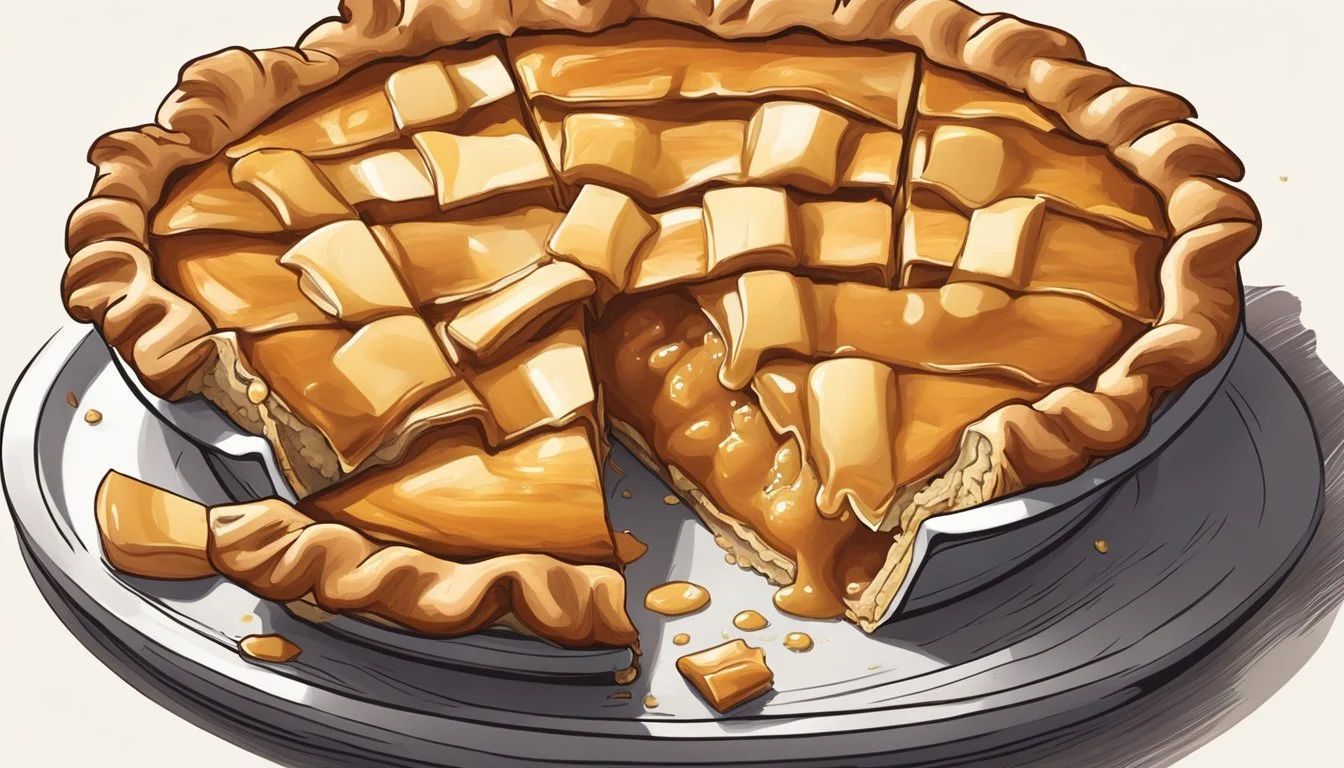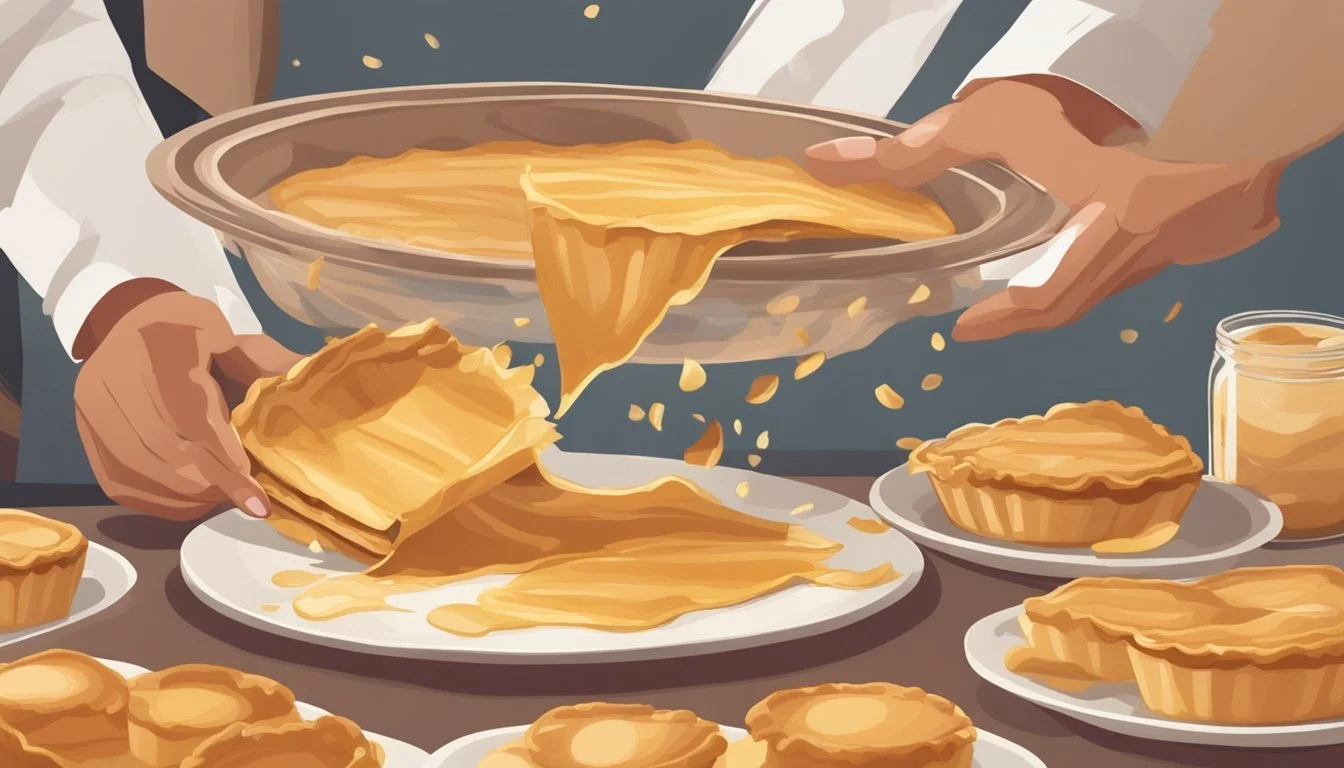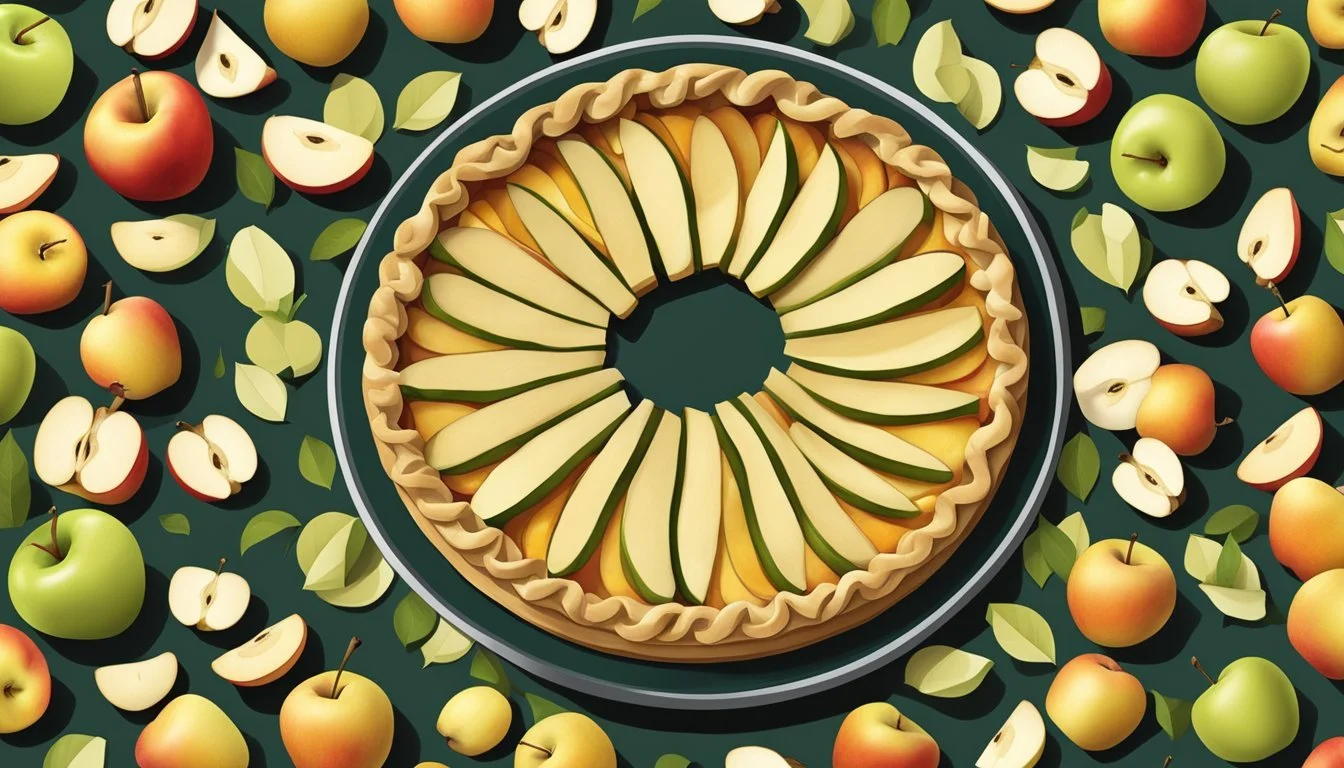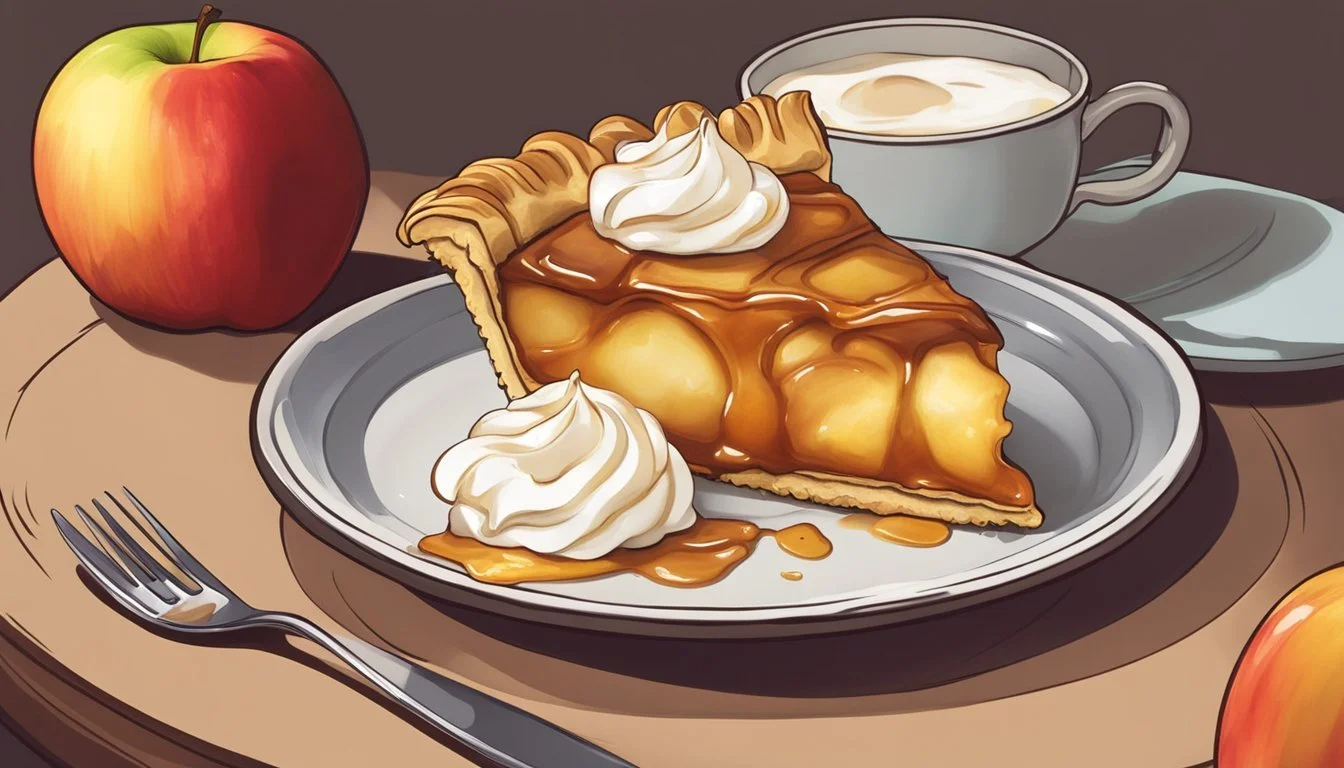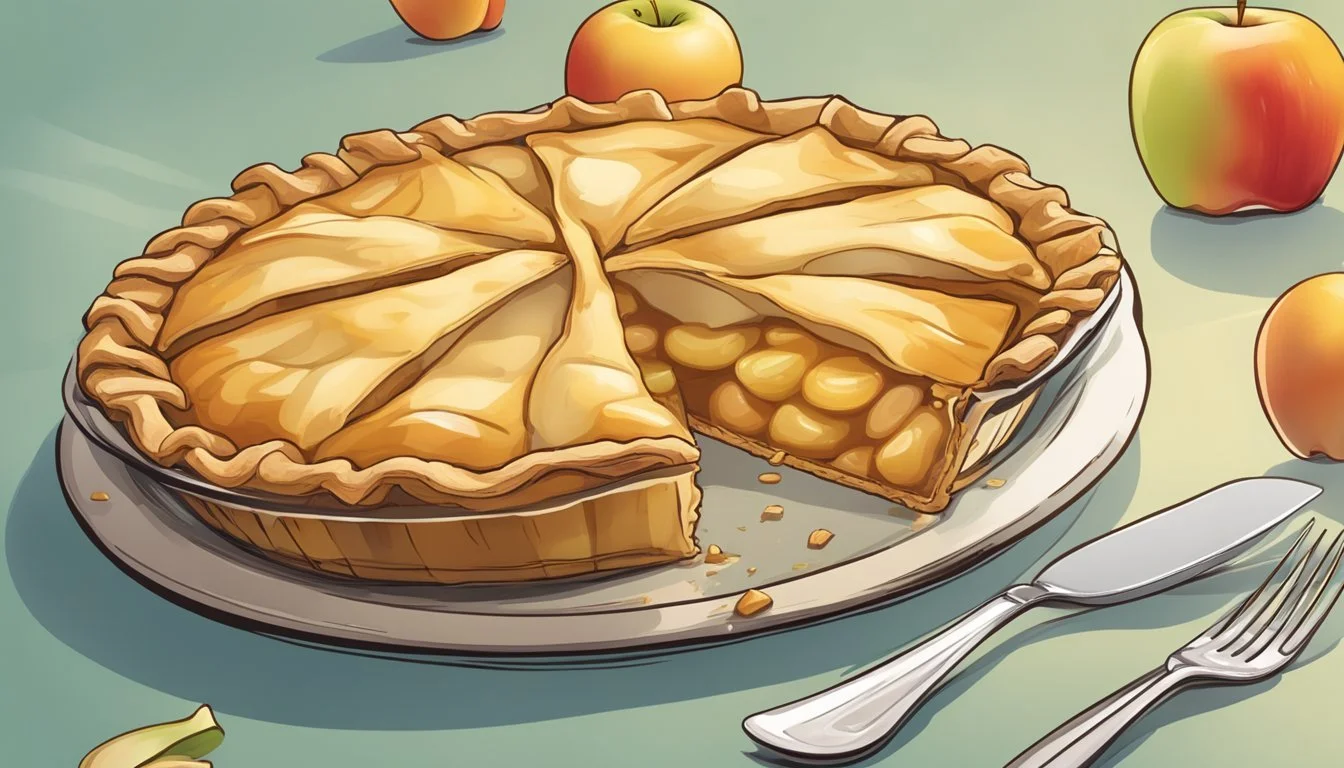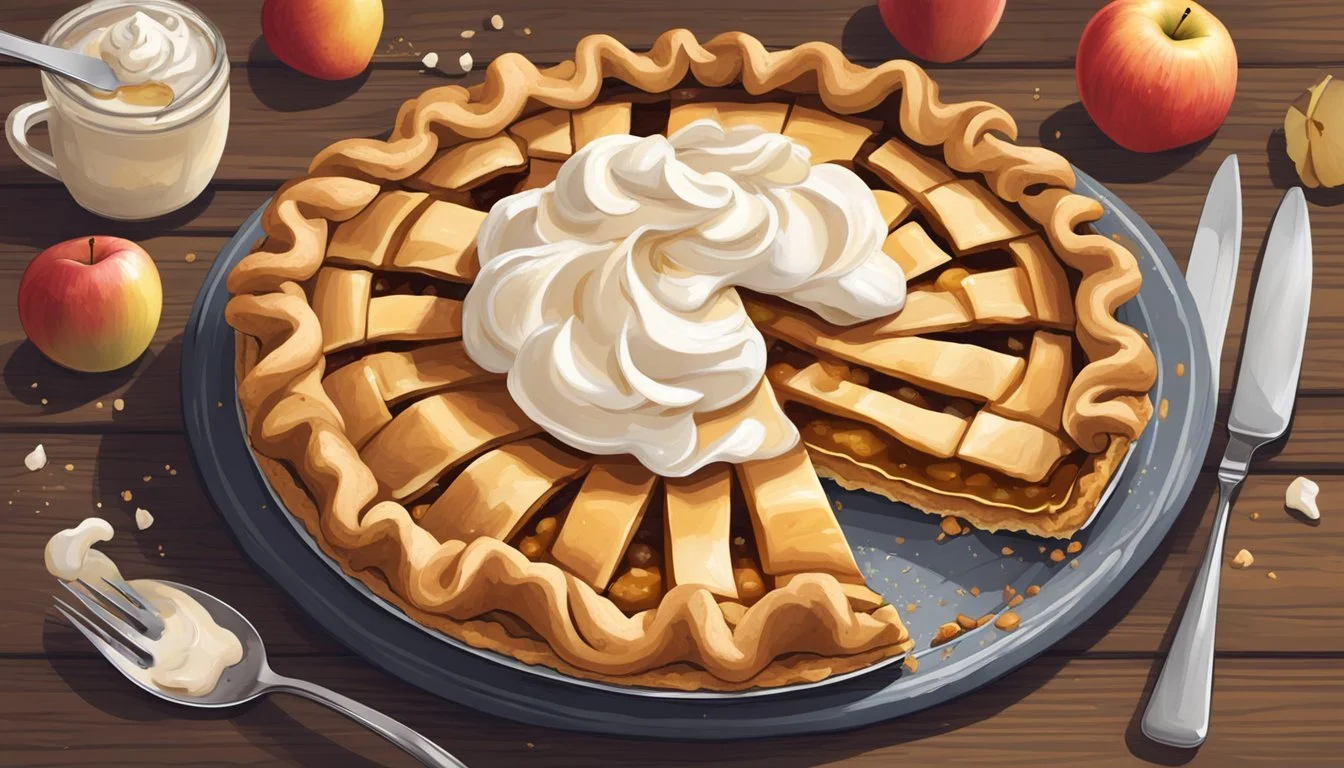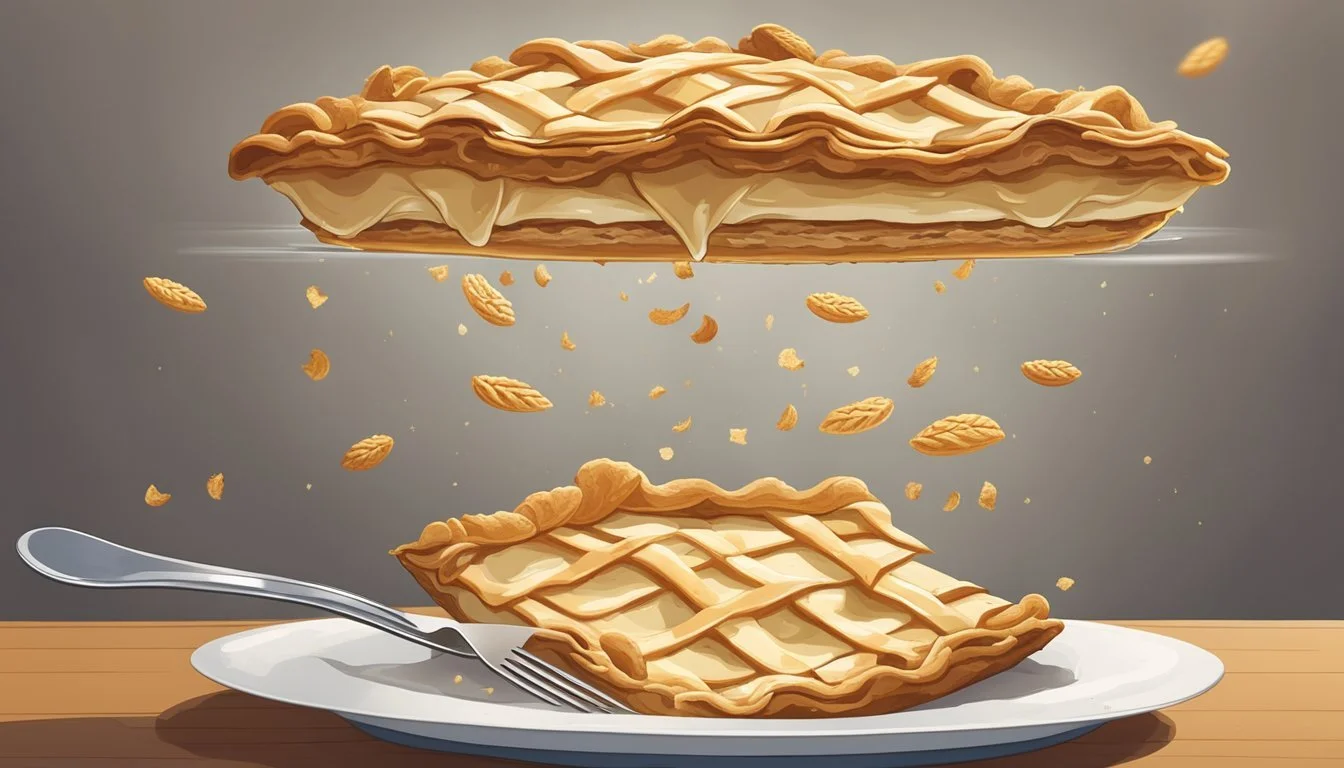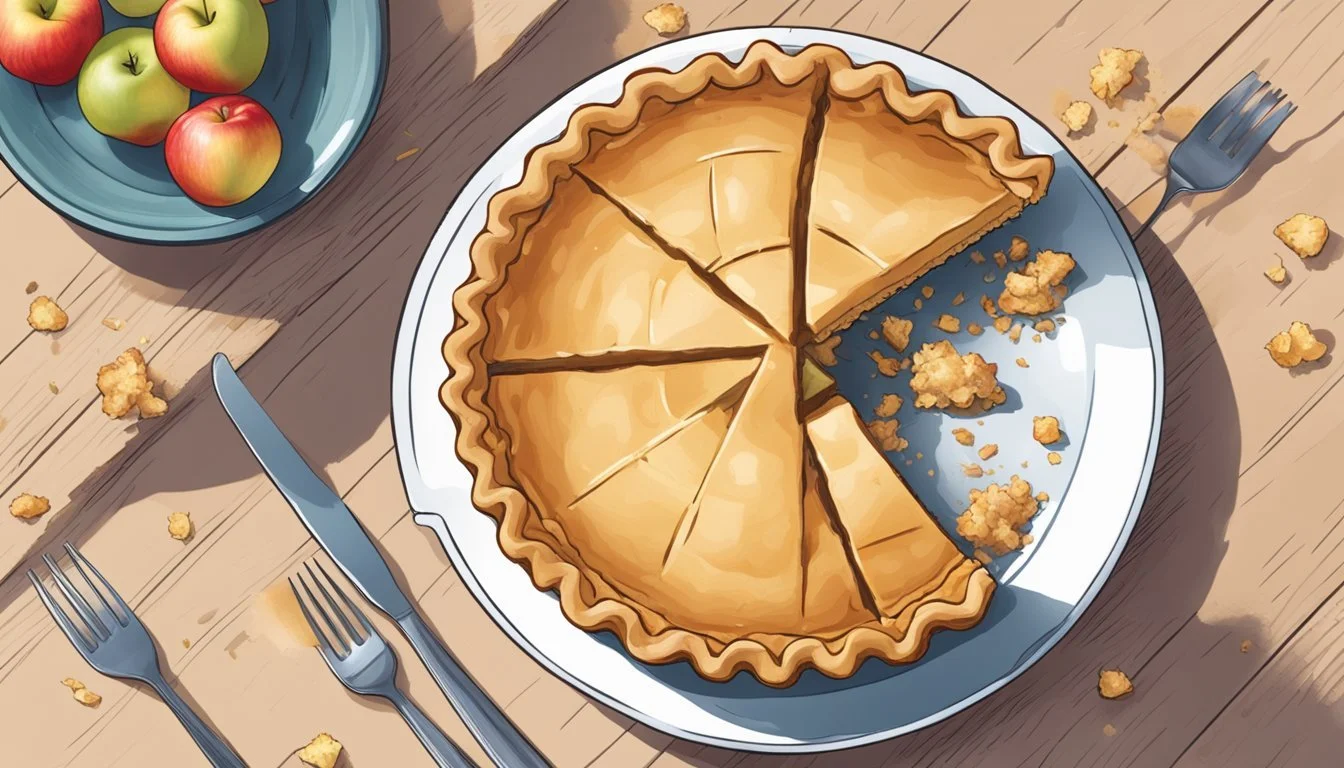How do you eat an upside-down apple pie?
Expert Tips for a Perfect Dessert Experience
An upside-down apple pie is a delightful twist on the traditional dessert, where the apples caramelize in a layer of butter and sugar at the bottom of the pan, creating a rich and gooey topping once inverted onto a serving plate. Unlike the classic apple pie, this variant promises a textural contrast with a sticky, candied surface that compliments the flaky pastry below. The technique essentially involves baking the pie with the crust on top and inverting it before serving to reveal the beautiful, caramelized apple layer that was once at the base.
Eating an upside-down apple pie isn't all too different from enjoying its right-side-up counterpart. However, the inverted presentation emphasizes the caramelized apple topping and the pecan garnish that becomes a delicious feature of the dessert’s aesthetic. As the pie is flipped, the pecans and the caramel meld with the tenderly baked apples, which elevates the overall flavor profile. This pie is often served warm, often accompanied by a scoop of vanilla ice cream or a dollop of whipped cream to balance the warm spice notes of the pie filling.
One might encounter various interpretations of this inverted dessert, from using a pie plate lined with parchment for easy release to the addition of aromatic spices such as cinnamon and nutmeg that complement the apples' natural sweetness. The beauty and complexity of the upside-down apple pie not only lies in its delectable flavors but also in the simple elegance of its unique presentation. Whether enjoyed in the cozy ambiance of a homely kitchen or as a featured dessert in a festive gathering, the upside-down apple pie holds its own as a beloved variant of a timeless classic.
History and Origin
The upside-down apple pie, often seen as a creative variation of the classic apple pie, embodies a rich history intertwining with American culture and traditions.
Thanksgiving Traditions
During Thanksgiving, apple pie serves as a staple dessert on many American tables. The tradition of including apple pie in Thanksgiving celebrations dates back to the time of the earliest settlers and has since then been synonymous with American festivities. This holiday has celebrated the traditional apple pie—with its flaky crust and sweet apple filling—but variations such as the upside-down apple pie have also made their appearances, offering a twist to the classic dessert. Upside-down apple pie typically involves layering apples caramelized in sugar and butter in a dish, topping them with pastry, and flipping the pie after baking to reveal a glossy, caramel-infused fruit layer.
Preparing the Pie Crust
A properly prepared pie crust is the foundation of a successful upside-down apple pie. For an upside-down pie, it’s important to choose the right type of crust and prepare your deep-dish pie plate accordingly to ensure the pie retains its structure when served.
Pie Crust Selection
When selecting a pie crust for an upside-down apple pie, one can choose between making a homemade crust using all-purpose flour, butter, and oil, or opting for convenience with refrigerated pie crusts. For those short on time, refrigerated pie crusts can be a reliable alternative. They provide a consistent texture and are ready-to-use, which simplifies the process considerably. Regardless of the choice, the crust should be compatible with a deep-dish pie plate, as this type of pie requires a crust that is sturdy enough to support the weight of the toppings once the pie is inverted.
Prepping the Deep-Dish Plate
To prep a deep-dish pie plate for an upside-down apple pie, one must ensure that the crust will not stick and the pie will easily release once baked and flipped. It is recommended to:
Line the pie plate with parchment paper or heavy-duty foil, extending beyond the edges to facilitate removal.
Generously apply nonstick cooking spray or butter to the lining to prevent sticking.
If using a homemade crust, roll the dough out evenly and lay it over the prepared pie plate, pressing firmly against the bottom and up the sides.
For refrigerated pie crusts, allow them to come to room temperature before unrolling and pressing into the plate to prevent tearing.
It is important to take care when pressing the crust into the pie plate, ensuring it is smooth and without air pockets that can cause the crust to bake unevenly. With these steps, the pie crust will be well-prepped for the layers of apple filling and inversion after baking.
Selecting Apples
Choosing the right apples is crucial for the success of an upside-down apple pie. The apples need to maintain their structure during baking and provide a balance of sweetness and tartness.
Apple Varieties
When selecting apples for an upside-down apple pie, one should consider varieties that hold their shape well when cooked and offer a pleasant contrast to the sweet caramel and flaky crust.
Granny Smith apples: These are a popular choice due to their firm texture and tart flavor which can complement the sweetness of the pie.
Braeburn: Offers a balanced sweet-tart flavor and also holds up well during cooking.
Honeycrisp: Known for their crisp texture and slightly sweet taste, making them a good option for baking.
Jonagold: A blend of Jonathan and Golden Delicious, with a sweet-tart flavor ideal for pies.
An ideal upside-down apple pie features a mix of apple varieties to achieve a complex flavor profile. Utilize a combination of tart apples such as Granny Smith with sweeter varieties to create a well-rounded taste. Opt for fresh, firm apples that are free of bruises and imperfections to ensure the pie retains its desired texture and aesthetic upon inverting.
Creating the Filling
The key to a delectable upside-down apple pie filling lies in the harmonious blend of its components. In creating a luscious filling, precision with ingredient quantities and a careful mixing technique are paramount.
Combining Ingredients for Filling
To begin, one requires thinly sliced apple slices, which serve as the foundation of the filling. These slices are usually combined with granulated sugar to provide sweetness and brown sugar for a deeper caramel note. The amount of sugar will vary, but one seeks to strike a balance, ensuring that the natural sweetness of the apples isn't overshadowed.
Ground cinnamon is then added, not just for its warming spice but also to complement the apples' flavor. Occasionally, a touch of lime juice may be included to bring a slight acidity which helps in highlighting the apples' taste and preserving their color.
Butter is employed not only to enhance the richness of the filling but also contributes to the luxurious texture of the cooked apples. For a binding agent and to absorb any excess juice released by the apples, a sprinkle of flour could be integrated into the mixture.
Here is a typical ingredient profile for the apple pie filling:
Ingredient Quantity Apple Slices 6 Cups Sugar ¾ Cup Brown Sugar ½ Cup Ground Cinnamon 1 Teaspoon Lime Juice 1 Tablespoon Butter 4 Tablespoons
The nutritional profile of the filling can vary but will encompass the following components:
Nutrient Amount (approx.) Calories 200-300 kcal/100g Fat 10-15g/100g Saturated Fat 5-7g/100g Protein 0-1g/100g Carbohydrates 40-60g/100g Cholesterol 10-30mg/100g Dietary Fiber 2-4g/100g Sodium 100-200mg/100g Sugars 30-40g/100g
It's essential to gently mix the ingredients to ensure the apple slices are fully coated without breaking them. This is a crucial step as it affects not only the distribution of flavors but also the consistency of the filling during baking. The resulting concoction is then ready to be layered into the pie for a confection that, once baked, offers both a luscious taste and an inviting aroma.
Assembling the Pie
When assembling an upside-down apple pie, precision in layering and adding toppings is crucial. The pie's signature inverted presentation demands a careful arrangement of ingredients to ensure a successful flip and an attractive, flavorful result.
Layering Techniques
The foundation of an upside-down apple pie involves a well-greased deep-dish pie plate, preferably lined with heavy-duty foil for easier handling. One starts by melting butter and mixing it with brown sugar and chopped pecans, then spreading this mixture evenly across the prepared pie plate. This base will ultimately become the top caramelized layer upon flipping the pie after baking.
The next step involves layering the apple mixture. Apples, typically peeled and sliced, should be combined with a mixture of granulated sugar, flour, and spices such as cinnamon and nutmeg to create a flavorful filling. This apple mixture is then carefully spooned over the pecan layer. Consistency in apple slice thickness is important for even cooking and presentation.
Adding Toppings
Once the apple filling is in place, it's time to top it with the pie crust. An unrolled crust is placed directly over the filling, with the edges of the crust then trimmed and folded over. Pressing down the edges seals the pie, containing the filling and caramel sauce that will form during baking. To allow steam to escape and avoid a soggy crust, the top should have several slits cut into it, forming a vent.
During baking, the juices from the apples will combine with the sugar and cinnamon, creating a delicious caramel sauce that will drizzle over the pie once it's inverted. The care taken in layering and sealing the pie ensures that, upon inversion, the pecans and caramel sauce provide a beautiful and tasty top layer.
Baking Instructions
When it comes to preparing an upside-down apple pie, accuracy in the baking process is crucial to achieve a perfect dessert. Careful attention should be given to oven settings, baking times, and applying the final touches.
Oven Preparation
The baker should preheat the oven to the correct temperature, typically around 350°F (175°C), to ensure that the pie bakes evenly. Heavy-duty foil can be used to line a 9-inch deep-dish pie plate, with edges extending over the side. Prior to pie assembly, the foil should be coated with cooking spray to prevent sticking.
Monitoring the Baking Time
Baking an upside-down apple pie typically takes about an hour. The baker must check the pie periodically to ensure it doesn't overbake. When the crust turns golden brown, and filling bubbles are observed, a toothpick can be inserted near the center to check for doneness. Adding slits in the top crust aids in venting steam and allows the inner part of the pie to bake thoroughly.
Final Touches
Once baking is completed, the pie should cool to stabilize its shape. Before serving, it might be brushed with a mixture of beaten egg and milk, or just milk, for a glossy finish. A careful whisk should be used to mix the wash and apply it gently with a pastry brush. For those who prefer additional spice, a sprinkle of nutmeg or apple pie spice could be added to the wash for an aromatic fall touch.
Serving the Pie
Serving an upside-down apple pie requires attention to detail to preserve its unique presentation and flavors. The process involves careful inverting of the pie onto a plate, enhancing its appearance, and adding final touches that complement the pie's taste and texture.
Inverting the Pie
Before inverting the upside-down apple pie, one must ensure the pie is warm to guarantee ease of release and the best texture. Preheat the oven and warm the pie if necessary before attempting to turn it out. Once warmed, place a serving platter over the top of the pie pan. With potholders or oven mitts, hold the platter and the pie pan firmly together and swiftly flip them over in one smooth motion. Remove the pie pan to reveal the apple pie with its topping now beautifully presented.
Presentation Tips
Once inverted, the upside-down apple pie's caramelized topping should present a visually appealing glaze that adds to the overall aesthetic. If serving the pie immediately after baking, the presentation can benefit from a pinch of salt or a sprinkle of cinnamon to enhance the inviting aroma. For texture contrast, place a scoop of vanilla ice cream next to the pie, and watch it slowly meld with the warm pie.
Final Garnishes
As for final touches, a dusting of powdered sugar can add a fine, snow-like appearance and slight sweetness. If additional spices such as nutmeg or cinnamon were used in the making of the pie, a light additional sprinkle of these can signify the flavors within. To elevate the dish further, a light drizzle of glaze over the pie or the ice cream can add sheen and deepen flavors, creating an even more remarkable dessert experience.
Nutritional Information
Nutritional content varies depending on the recipe ingredients and serving size. A typical serving of upside-down apple pie contains calories, fats, proteins, and other nutrients in different quantities.
Calories: Each slice of upside-down apple pie is likely to provide a significant number of calories due to its rich ingredients like butter, sugar, and flour. On average, a slice can have approximately 300 to 500 calories.
Fat: This dessert is high in fat, with butter present both in the crust and the caramelized topping. Total fat content can range from 10 to 20 grams per serving, with saturated fats accounting for about 4 to 7 grams.
Protein: The protein in upside-down apple pie comes primarily from the eggs in the dough and small amounts contributed by the flour. A slice could provide between 3 and 5 grams of protein.
Cholesterol: Due to the presence of butter and eggs, upside-down apple pie can have a higher cholesterol content, possibly around 20 to 40 milligrams per slice.
Dietary Fiber: Apples are a good source of dietary fiber. This dessert could offer between 2 to 4 grams of fiber per slice, depending on the number and type of apples used.
Sugars: Upside-down apple pie contains high levels of sugars, which come from both the fruit and the added sweeteners. Sugars can range widely, sometimes exceeding 20 grams per serving.
Sodium: The amount of sodium in a slice of pie is typically low to moderate, influenced by the presence of salt in the dough and any added to the apple filling. Sodium content may be about 100 to 300 milligrams per slice.
Here is an example of how these nutrition facts could be laid out for a single slice of pie:
Nutrient Amount per Serving Calories 400 kcal Fat 15 g Saturated Fat 6 g Protein 4 g Cholesterol 30 mg Dietary Fiber 3 g Sugars 25 g Sodium 200 mg
It’s important for individuals to consider these nutritional factors, especially when factoring dessert into a balanced diet.
Alternative Versions
When it comes to enjoying an upside-down apple pie, there are variations to suit different dietary needs and seasonal preferences. These adaptations ensure that the delectable experience of savoring this classic apple dessert is accessible to a wider audience.
Dietary Adjustments
For those looking to tailor the upside-down apple pie to specific dietary requirements, various substitutions can be made.
Sugar-free: Replace traditional sugar with sugar substitutes like stevia or erythritol to cut down on the sugar content.
Gluten-free: Utilize gluten-free flour blends for the crust, ensuring the pie is safe for those with gluten intolerances or celiac disease.
Vegan: Substitute butter with plant-based alternatives like coconut oil or vegan butter, and use a vegan pie crust.
Incorporating these substitutions can help maintain the integrity of the pie while making it accessible to those with dietary restrictions.
Seasonal Variations
Seasonal twists on the traditional upside-down apple pie can bring a refreshing change to the dessert table, especially in fall when apple flavors are particularly celebrated.
Pumpkin Pie: Introduce pumpkin puree and pumpkin spice into the filling for a harvest-themed treat.
Pecan Pie: Instead of the usual apple layer, one can layer pecans and syrup underneath the crust for a nutty, caramelized alternative during the festive season.
These seasonal variations not only celebrate the flavors of fall but also offer a delightful twist to the classic upside-down pie, ensuring they remain a staple at gatherings across the year.
Storage and Leftovers
When preserving an upside-down apple pie, the goal is to maintain its freshness and delightful texture. For optimal storage, one should utilize refrigerated pie crusts which offer convenience and often include recommended storage instructions to ensure the pie remains tasty upon reheating.
For Immediate Consumption:
If planning to serve the pie within a short period, store it at room temperature.
Place the pie in an airtight container to keep it moist and to prevent it from absorbing other odors.
Refrigeration:
Wrap the pie in plastic wrap or foil to safeguard against air and moisture.
Refrigerated upside-down apple pies can last up to 4 days.
Freezing Instructions:
For long-term storage, tightly wrap the pie in foil or place it inside a freezer bag, removing as much air as possible.
Label with the current date; a properly stored pie can be kept frozen for up to 4 months.
Reheating:
To serve warm, thaw the refrigerated or frozen pie in the refrigerator if frozen, and reheat in the oven until it reaches the desired temperature.
Avoid microwaving, as it may unevenly heat the pie and affect its texture.
By carefully wrapping and storing your upside-down apple pie in an appropriate environment—be it room temperature, the refrigerator, or the freezer—you can enjoy your dessert at its best even days after baking. Remember to add a touch of sugar on top before serving for that extra sparkle of flavor.
Pairing Suggestions
When enjoying an upside-down apple pie, it is complemented well by a scoop of vanilla ice cream. The creaminess of the ice cream juxtaposes with the warmth and texture of the pie, creating a delightful taste sensation. Alternatively, a drizzle of caramel sauce can enhance the pie's existing flavors, adding a silky, sweet note that ties together the caramelized apple taste inherent in the dessert.
For beverages, apple cider, hot or cold, serves as an excellent accompaniment. The tart yet sweet profiles of both the cider and pie amplify each other, making for a harmonious pairing. If one prefers a hotter beverage, particularly during cooler months, coffee is a worthy candidate. The robust bitterness of a good brew can cut through the sweetness of the pie, offering a balance that invigorates the palate.
While these accompaniments are suggested, the pie can undoubtedly stand on its own as a splendid dessert. The choice of pairing should align with the diner's taste preference and the context of the meal.
Pairing Option Reason for Pairing Vanilla Ice Cream Adds a creamy texture and cooling contrast Caramel Sauce Enhances the sweetness and complements the apples Apple Cider Echoes the apple flavor in the pie, can be served hot or cold Coffee Offers a bitterness to balance the sweet flavors
Common Challenges and Tips
Eating an upside-down apple pie can be just as enjoyable as a traditional pie, but it comes with unique challenges such as serving without it falling apart and ensuring a consistent flavor balance. The following subsections address common pitfalls and provide answers to frequently asked questions.
Avoiding Common Mistakes
Handling the Pie Post-Bake
One challenge of an upside-down pie is the risk of it collapsing when inverted. To avoid this, they must ensure the pie has cooled enough to set its shape but is still warm enough to release from the deep-dish pie plate. The use of parchment paper can aid in the pie's release.
Nutritional Concerns
For nutritional balance, knowing the ingredients is crucial. A regular slice of upside-down apple pie contains:
Calories: Ranging from 300-500
Carbohydrates: Approximately 50-70g
Sugars: About 30-40g
These values may vary based on the content of sugar, flour, and butter used. If the pie contains nuts, like pecans, this also adds to the nutritional content, particularly in terms of fats and proteins.
Baking Technique
The crust preparation is vital. A refrigerated pie crust can be used for convenience, but it's important to press it firmly against the nut mixture and up the sides when layering. When baking, placing the oven rack in the center position ensures even heat distribution.
FAQs Answered
How do I achieve a non-soggy bottom crust?
Ensure the crust is thoroughly baked by setting the correct oven temperature, typically around 375 degrees F, and bake until the crust is golden brown. This usually takes about 1 to 1 and 1/4 hours.
What can cause the filling to be runny and how can it be prevented?
A runny filling can result from insufficient thickening agents or overly juicy apples. To prevent this, they can mix the apple slices with the correct proportions of flour and sugar to absorb excess moisture.
By maintaining these techniques and answering these questions, one can enjoy the unique taste and presentation of an upside-down apple pie without facing typical setbacks.
Final Thoughts and Reflections
When one approaches the concept of the upside-down apple pie, they experience a delightful twist to the classic apple pie. This unique variation still honors the traditional elements of a homemade pie: crisp apples, warm spices, and a tender, flaky crust.
Serving an upside-down apple pie requires a specific technique. One must allow the pie to cool slightly; then, with confidence and care, invert the pie onto a serving plate. The reveal is part of the marvel, showcasing a glistening caramelized top now at the base, adorned with nuts or other embellishments.
Thanksgiving dinner often serves as a stage for traditional desserts, and an upside-down apple pie can be a beautiful addition to this culinary performance. It allows the cook to demonstrate their mastery of baking, while also offering a unique take on the classic apple pie.
Texture and Flavor:
The caramelization adds depth.
Apples maintain their structural integrity, providing a satisfying texture.
A buttery crust becomes the crown of the pie, rather than its base.
In comparison to traditional varieties, the upside-down apple pie encourages bakers to explore and guests to enjoy a different facet of an all-time favorite. It neither competes with nor overshadows the classic apple pie, but it offers a memorable experience of its own. It's a homage to the homemade, a tribute to the timeless, and a wonderful twist to be savored with each bite.
Related Topics and Further Reading
Baked Apples as a Dessert Alternative: For those who enjoy the flavors within an upside-down apple pie, exploring the simple classic that is baked apples can be quite rewarding. The same warm spices used in apple pies, such as cinnamon and nutmeg, can be used to enhance the taste of baked apples.
Cooking Techniques for Thinly Sliced Apples: A critical component for both upside-down apple pies and a variety of apple recipes is the proper preparation of thinly sliced apples. Readers may find value in learning various cutting techniques for apples that ensure even cooking and aesthetically pleasing presentations in desserts.
Fall Cooking and Apple Recipes: Fall is synonymous with apple season. Cooks can delve into the myriad of apple recipes that celebrate the harvest. Noble Pig and similar culinary blogs often feature creative twists on classic apple-centric dishes that can be a delight for home chefs to explore.
Enhancing Apple Desserts: Beyond the primary preparation, understanding how to enhance the flavor profile of an apple dessert can be essential. This ranges from selecting the right apple variants for different types of desserts, such as using tart Granny Smith apples for pies, to pairing with other elements like caramel or ice cream.
Topic Resources for Exploration Baked Apples Cooking Blogs, Culinary Magazines Apple Slicing YouTube Tutorials, Cooking Classes Apple Season Recipes Food Networks, Seasonal Cookbooks Dessert Pairings Culinary Websites, Dessert and Baking Forums
For detailed recipes, instructions, and cooking inspiration, food enthusiasts may refer to various cookbooks and culinary websites that specialize in desserts and seasonal cooking.
Acknowledgments
In the creation of an article about the culinary delight and serving intricacies of the upside-down apple pie, recognition must be given to several sources.
Recipe Developers: Those culinary professionals and home-cooking aficionados who have perfected the art of the upside-down apple pie deserve gratitude. Their work to balance the flavors and textures establishes the foundation for enjoying this dessert.
Culinary Experts: Knowledge from seasoned chefs and bakers guides individuals in the correct techniques of flipping, presenting, and serving the pie. Their expertise ensures that the upside-down apple pie retains its shape and garners appreciation at the dining table.
Cultural Contributors: Various cultures have influenced the upside-down apple pie, with traditions that add unique twists to the classic dish. Their contributions diversify the way this pie can be experienced and enjoyed.
Readers and Home Cooks: Readers and home cooks who engage with upside-down apple pie recipes and share their experiences add real-world insights. They are crucial in understanding the practical aspects of eating an upside-down apple pie, such as the best utensils to use and how to serve it neatly.
Each acknowledgment is pivotal as they collectively contribute to the wealth of knowledge surrounding the serving and enjoyment of the upside-down apple pie.

